Effect of Street Asymmetry, Albedo, and Shading on Pedestrian Outdoor Thermal Comfort in Hot Desert Climates
Abstract
1. Introduction
1.1. Outdoor Thermal Comfort in Urban Canyon Studies
1.2. Literature Review
2. Methodology
2.1. Study Context and Selected Area Description
2.1.1. Defining the Selection Criteria
- Northwest—southeast orientations are highly recommended for these climate areas [70].
- The presence of arcades (covered sidewalks) on both sides is strongly recommended within Algerian urban planning regulations specifically for main streets.
2.1.2. Zoning Division
2.2. Field Measurement and Collecting Data
2.3. Microclimate ENVI-Met Software
2.3.1. ENVI-Met Settings and Details of Input Data
2.3.2. ENVI-Met Output Data
- First: obtain the average values to assess the impact of the designed scenarios on the entire study area.
- Second: obtain receptor values defined to assess the impact of scenarios on pedestrian areas within four principal points—(A) the southwest sidewalk below the arcades; (B); southwest sidewalk outside the arcades; (C) northeast sidewalk outside the arcades; (D) northeast sidewalk below the arcades; and (E) center of the street (for comparison).
- Third: determine the values for each grid unit within a representative section of the street to draw the spatiotemporal distribution of the scenarios’ impact.

2.4. ENVI-Met Validation
2.5. PET and RayMan Model to Assess the OTC
2.6. Baseline Model Assessment
2.7. Mitigation Scenarios
- Scenario 1 (SC1): This features an asymmetric profile, where the northeast side represents the tallest buildings’ side of the boulevard and the southwest takes the mean height.
- Scenario 2 (SC2): Inversion of the asymmetric sides of the scenario 1 (SC1).
- Scenario 3 (SC3): Utilization of cool pavement. Thus, the road is stamped by light concrete pavement with an albedo of 0.5 and emissivity of 0.9, whereas the sidewalks are covered by light concrete pavement with an albedo of 0.8 and emissivity of 0.9.
- Scenario 4 (SC4): A horizontal canopy has been designed to cover the sidewalks outside the arcades, covering the surface beyond the arcades.
- Scenario 5 (SC5): Implementation of Ficus Retusa, which is a commonly used tree species in urban arrangements in the region [50]. These trees, about 12 m in height (modeled by Albero), have been aligned on both sides of the boulevard within the sidewalks outside the arcades.
3. Results and Discussion
3.1. Scenarios Effect in Thermal Conditions of the Study Area
3.2. Scenarios Effect in OTC of Pedestrian Areas
3.3. Spatiotemporal Distribution of PET
3.4. Findings and Recommendations
- Arcades on both sides of ‘Emir Abdelkader Boulevard’ provided optimal conditions throughout the daytime hours compared to adjacent areas. During peak hours, the difference in PET values between the boulevard’s middle area and the SWS and NES in SC0, reached 5.3 °C and 2.1 °C, respectively. This design element was investigated in two previous studies and provided effective results in enhancing summer human-thermal conditions [37,86]. Unlike urban shading canopies, arcades benefit from the building structure as additional vertical protection from direct solar radiation and maintain lower temperatures within themselves during long daytime hours. It should be noted that the effectiveness of arcades depends on their width. Therefore, the addition of horizontal shading in SC4 (with an enlargement of arcade width from 4 m to 6 m) improved PET reduction within 2 m from the façade’s edge by up to 2.4 °C. Accordingly, this strategy is a valuable tool for urban designers to enhance the pedestrian OTC, although it is essential to consider the required visibility and openness of the street. The width of arcades should not impart a feeling of enclosure.
| Strategy | Study Findings and Design Preferences |
|---|---|
| Asymmetry |
|
| Design preference: According to Qaid and Ossen (2015), an asymmetrical profile obstructing the western sun in the latter half of the day is more desirable than the opposite profile obstructing the eastern sun [44]. Therefore, it is recommended to have an asymmetrical profile with an SWS > NES orientation. | |
| High-albedo |
|
| Design preference: Implementing cool paving on pedestrian areas under and outside arcades and incorporating shading canopies for the areas outside arcades, while excluding the use of cool paving on the road. | |
| Shading |
|
| Design preference: The implementation of horizontal shading on NES and tree shading on SWS (based on the best results from the modeled scenarios). |
- The horizontal shading implemented in the study can be considered as (i) an additional expansion for arcades and (ii) an alternative strategy for arcades in their reconstruction (in urban rehabilitation operations). Considering the summer and winter requirements, horizontal shading can be used as a temporary solution for summer conditions. In this regard, the movable vertical screen developed by Swaid and Hoffman (1990) can be simulated [46]. A movable horizontal canopy can be installed as an extension of arcades during the summer and adjusted as needed in other seasons. It crucial to emphasize that the results obtained regarding horizontal shading depend on the material and thickness of the used building material surface [18]. This study specifically utilized a concrete surface with a thickness of 0.2 m.
- Street trees have led to a significant reduction in Ta levels during the daytime hours, emphasizing the importance of greenery in mitigating urban heat island (UHI) effects [14,53,57,58,59,123]. Furthermore, comparing urban design elements at the pedestrian level, specifically outside the arcades (directly below the trees’ canopies and the horizontal shading surfaces), showed that horizontal shading achieved nearly optimal results of OTC. This result can be explained by (i) the flat concrete surface’s ability to reflect a higher amount of short-wave radiation and (ii) the density of ‘Ficus Retusa’ trees used on both sides, which traps a higher amount of long-wave radiation emitted from shaded ground surfaces [101]. Using trees on one street side can provide sufficient space for the dispersion of long-wave radiation throughout the pedestrian area. Overall, the results regarding the effect of tree shading at the pedestrian level indicate that a limited-scale assessment is necessary to make optimized decisions regarding the position, arrangement, and types of planted trees [53,54,55,56,112].
4. Limitations of the Study
5. Conclusions
- Asymmetrical streets provide an alternative flexible geometry that maintains street openness and ensures more adaptability in modifying pedestrian thermal conditions. Opposite asymmetric profiles show a disparity in improving PET values between morning and evening hours. It is recommended to arrange the evening improvement option for city cooling strategies.
- Using high-albedo paving coupled with shading strategies is recommendable. High-albedo ground surfaces contribute to enhancing PET, which is initially improved under shading canopies. Using cool pavements in areas that lack shade had no significant impact on pedestrian thermal comfort. Therefore, several studies reported its negative effect on thermal and visual comfort. A control of the sky view factor is necessary when considering such materials.
- Adopting localized shading canopies is one of the most effective strategies for mitigating outdoor heat stress. Within the design options considered, each option offers some characteristics that should be taken into consideration:
- -
- Arcades provide a crucial shading strategy, offering a mix of horizontal and vertical shading at the pedestrian level. Sub-areas below arcades on both sides offer better thermal conditions on the street throughout the day. Arcades’ effectiveness depends on their depth. However, excessive depth should be avoided to prevent a sense of enclosure.
- -
- Building-mounted horizontal shading provides a good alternative to arcade canopies in urban rehabilitation processes. It can also serve as an additional depth for them within specific seasonal settings. The effectiveness of this strategy depends on the canopy material, which may exceed the efficiency of tree shading.
- -
- Single-sided tree planting is preferable for street design. When using trees (such as “Ficus Retusa” with large canopies) on both sides, the higher radiation levels occurring between tree shadows in the center of the street should be considered, as it can reduce the climatic performance of trees at the pedestrian level.
Author Contributions
Funding
Institutional Review Board Statement
Informed Consent Statement
Data Availability Statement
Acknowledgments
Conflicts of Interest
Nomenclature
| MBE | Mean Bias Error |
| N-E | Northeast |
| NES | Northeast Side |
| OTC | Outdoor Thermal Comfort |
| PET | Physiological Equivalent Temperature |
| RH | Relative Humidity |
| RMSE | Root Mean Square Error |
| R² | Coefficient of determination |
| S-W | Southwest |
| SWS | Southwest Side |
| Ta | Air temperature |
| Tmrt | Mean radiant temperature |
| Va | Air velocity |
| UHI | Urban Heat Island |
| CFD | Computational Fluid Dynamics |
References
- Singh, R. Factors Affecting Walkability of Neighborhoods. Procedia Soc. Behav. Sci. 2016, 216, 643–654. [Google Scholar] [CrossRef]
- Moura, F.; Cambra, P.; Gonçalves, A.B. Measuring Walkability for Distinct Pedestrian Groups with a Participatory Assessment Method: A Case Study in Lisbon. Landsc. Urban. Plan. 2017, 157, 282–296. [Google Scholar] [CrossRef]
- Habibian, M.; Hosseinzadeh, A. Walkability Index across Trip Purposes. Sustain. Cities Soc. 2018, 42, 216–225. [Google Scholar] [CrossRef]
- Labdaoui, K.; Mazouz, S.; Acidi, A.; Cools, M.; Moeinaddini, M.; Teller, J. Utilizing Thermal Comfort and Walking Facilities to Propose a Comfort Walkability Index (CWI) at the Neighbourhood Level. Build. Environ. 2021, 193, 107627. [Google Scholar] [CrossRef]
- Zhong, J.; Liu, W.; Niu, B.; Lin, X.; Deng, Y. Role of Built Environments on Physical Activity and Health Promotion: A Review and Policy Insights. Front. Public. Health 2022, 10, 950348. [Google Scholar] [CrossRef]
- Leporelli, E.; Santi, G. From Psychology of Sustainability to Sustainability of Urban Spaces: Promoting a Primary Prevention Approach for Well-Being in the Healthy City Designing. A Waterfront Case Study in Livorno. Sustainability 2019, 11, 760. [Google Scholar] [CrossRef]
- Ali, M.; Dharmowijoyo, D.B.E.; de Azevedo, A.R.G.; Fediuk, R.; Ahmad, H.; Salah, B. Time-Use and Spatio-Temporal Variables Influence on Physical Activity Intensity, Physical and Social Health of Travelers. Sustainability 2021, 13, 12226. [Google Scholar] [CrossRef]
- Crane, M.; Lloyd, S.; Haines, A.; Ding, D.; Hutchinson, E.; Belesova, K.; Davies, M.; Osrin, D.; Zimmermann, N.; Capon, A. Transforming Cities for Sustainability: A Health Perspective. Environ. Int. 2021, 147, 106366. [Google Scholar] [CrossRef]
- Azmi, D.I.; Ahmad, P. A GIS Approach: Determinant of Neighbourhood Environment Indices in Influencing Walkability between Two Precincts in Putrajaya. Procedia Soc. Behav. Sci. 2015, 170, 557–566. [Google Scholar] [CrossRef][Green Version]
- Yin, L. Street Level Urban Design Qualities for Walkability: Combining 2D and 3D GIS Measures. Comput. Environ. Urban. Syst. 2017, 64, 288–296. [Google Scholar] [CrossRef]
- Wang, H.; Yang, Y. Neighbourhood Walkability: A Review and Bibliometric Analysis. Cities 2019, 93, 43–61. [Google Scholar] [CrossRef]
- Elnabawi, M.H.; Hamza, N. Behavioural Perspectives of Outdoor Thermal Comfort in Urban Areas: A Critical Review. Atmosphere 2019, 11, 51. [Google Scholar] [CrossRef]
- Ma, X.; Chau, C.K.; Lai, J.H.K. Critical Factors Influencing the Comfort Evaluation for Recreational Walking in Urban Street Environments. Cities 2021, 116, 103286. [Google Scholar] [CrossRef]
- Oke, T.R. City Size and the Urban Heat Island. In Atmospheric Environment (1967); Elsevier: Amsterdam, The Netherlands, 1973; Volume 7, pp. 769–779. [Google Scholar]
- Oke, T.R. Boundary Layer Climates; Routledge: London, UK, 2002; ISBN 1134951337. [Google Scholar]
- Brown, R.D. Design with Microclimate: The Secret to Comfortable Outdoor Space; Island Press: Washington, DC, USA, 2010; ISBN 1597269891. [Google Scholar]
- Givoni, B. Climate Considerations in Building and Urban Design; John Wiley & Sons: Hoboken, NJ, USA, 1998; ISBN 0471291773. [Google Scholar]
- Santos Nouri, A.; Costa, J.P.; Santamouris, M.; Matzarakis, A. Approaches to Outdoor Thermal Comfort Thresholds through Public Space Design: A Review. Atmosphere 2018, 9, 108. [Google Scholar] [CrossRef]
- Abdallah, A.S.H.; Al-Saadi, S.N.J. Outdoor Space Quality: Impact of Deep Canyon Thermal Comfort in an Urban Residential Community. Sci. Technol. Built Environ. 2020, 27, 477–488. [Google Scholar] [CrossRef]
- Cárdenas-Jirón, L.A.; Graw, K.; Gangwisch, M.; Matzarakis, A. Influence of Street Configuration on Human Thermal Comfort and Benefits for Climate-Sensitive Urban Planning in Santiago de Chile. Urban. Clim. 2023, 47, 101361. [Google Scholar] [CrossRef]
- Rodríguez-Algeciras, J.; Tablada, A.; Matzarakis, A. Effect of Asymmetrical Street Canyons on Pedestrian Thermal Comfort in Warm-Humid Climate of Cuba. Theor. Appl. Clim. 2018, 133, 663–679. [Google Scholar] [CrossRef]
- Lai, D.; Liu, W.; Gan, T.; Liu, K.; Chen, Q. A Review of Mitigating Strategies to Improve the Thermal Environment and Thermal Comfort in Urban Outdoor Spaces. Sci. Total Environ. 2019, 661, 337–353. [Google Scholar] [CrossRef]
- Deng, J.Y.; Wong, N.H. Impact of Urban Canyon Geometries on Outdoor Thermal Comfort in Central Business Districts. Sustain. Cities Soc. 2020, 53, 101966. [Google Scholar] [CrossRef]
- Ali-Toudert, F.; Mayer, H. Numerical Study on the Effects of Aspect Ratio and Orientation of an Urban Street Canyon on Outdoor Thermal Comfort in Hot and Dry Climate. Build. Environ. 2006, 41, 94–108. [Google Scholar] [CrossRef]
- Jamei, E.; Rajagopalan, P.; Seyedmahmoudian, M.; Jamei, Y. Review on the Impact of Urban Geometry and Pedestrian Level Greening on Outdoor Thermal Comfort. Renew. Sustain. Energy Rev. 2016, 54, 1002–1017. [Google Scholar] [CrossRef]
- Erell, E.; Pearlmutter, D.; Williamson, T. Urban Microclimate: Designing the Spaces between Buildings; Routledge: London, UK, 2012; ISBN 1136539433. [Google Scholar]
- Ketterer, C.; Matzarakis, A. Human-Biometeorological Assessment of Heat Stress Reduction by Replanning Measures in Stuttgart, Germany. Landsc. Urban. Plan. 2014, 122, 78–88. [Google Scholar] [CrossRef]
- Oke, T.R. Street Design and Urban Canopy Layer Climate. Energy Build. 1988, 11, 103–113. [Google Scholar] [CrossRef]
- Xu, X.; Gao, Z.; Zhang, M. A Review of Simplified Numerical Approaches for Fast Urban Airflow Simulation. Build. Environ. 2023, 234, 110200. [Google Scholar] [CrossRef]
- Tsoka, S.; Tsikaloudaki, A.; Theodosiou, T. Analyzing the ENVI-Met Microclimate Model’s Performance and Assessing Cool Materials and Urban Vegetation Applications–A Review. Sustain. Cities Soc. 2018, 43, 55–76. [Google Scholar] [CrossRef]
- Nouri, A.S.; Charalampopoulos, I.; Matzarakis, A. The Application of the Physiologically Equivalent Temperature to Determine Impacts of Locally Defined Extreme Heat Events within Vulnerable Dwellings during the 2020 Summer in Ankara. Sustain. Cities Soc. 2022, 81, 103833. [Google Scholar] [CrossRef]
- Aboelata, A. Reducing Outdoor Air Temperature, Improving Thermal Comfort, and Saving Buildings’ Cooling Energy Demand in Arid Cities–Cool Paving Utilization. Sustain. Cities Soc. 2021, 68, 102762. [Google Scholar] [CrossRef]
- Luo, J.; Yang, H. A State-of-the-Art Review on the Liquid Properties Regarding Energy and Environmental Performance in Liquid Desiccant Air-Conditioning Systems. Appl. Energy 2022, 325, 119853. [Google Scholar] [CrossRef]
- Luo, J.; Yang, K.; Liu, Y.; Zhao, Z.; Chen, G.; Wang, Q. Experimental and Theoretical Assessments on the Systematic Performance of a Single-Stage Air-Source Heat Pump Using Ternary Mixture in Cold Regions. Appl. Therm. Eng. 2023, 234, 121300. [Google Scholar] [CrossRef]
- Ahmad, K.; Khare, M.; Chaudhry, K.K. Wind Tunnel Simulation Studies on Dispersion at Urban Street Canyons and Intersections—A Review. J. Wind. Eng. Ind. Aerodyn. 2005, 93, 697–717. [Google Scholar] [CrossRef]
- Rodríguez-Algeciras, J.; Tablada, A.; Nouri, A.S.; Matzarakis, A. Assessing the Influence of Street Configurations on Human Thermal Conditions in Open Balconies in the Mediterranean Climate. Urban. Clim. 2021, 40, 100975. [Google Scholar] [CrossRef]
- Ali-Toudert, F.; Mayer, H. Effects of Asymmetry, Galleries, Overhanging Façades and Vegetation on Thermal Comfort in Urban Street Canyons. Sol. Energy 2007, 81, 742–754. [Google Scholar] [CrossRef]
- Johansson, E. Influence of Urban Geometry on Outdoor Thermal Comfort in a Hot Dry Climate: A Study in Fez, Morocco. Build. Environ. 2006, 41, 1326–1338. [Google Scholar] [CrossRef]
- Nasrollahi, N.; Namazi, Y.; Taleghani, M. The Effect of Urban Shading and Canyon Geometry on Outdoor Thermal Comfort in Hot Climates: A Case Study of Ahvaz, Iran. Sustain. Cities Soc. 2021, 65, 102638. [Google Scholar] [CrossRef]
- Shashua-Bar, L.; Tzamir, Y.; Hoffman, M.E. Thermal Effects of Building Geometry and Spacing on the Urban Canopy Layer Microclimate in a Hot-humid Climate in Summer. Int. J. Clim. 2004, 24, 1729–1742. [Google Scholar] [CrossRef]
- Nasrollahi, N.; Ghosouri, A.; Khodakarami, J.; Taleghani, M. Heat-Mitigation Strategies to Improve Pedestrian Thermal Comfort in Urban Environments: A Review. Sustainability 2020, 12, 10000. [Google Scholar] [CrossRef]
- Brès, A. Le Système des Voies Urbaines: Entre Réseau et Espace. FLUX Cah. Sci. Int. Rés. Territ. 1998, 14, 4–20. [Google Scholar]
- Taleghani, M. Outdoor Thermal Comfort by Different Heat Mitigation Strategies—A Review. Renew. Sustain. Energy Rev. 2018, 81, 2011–2018. [Google Scholar] [CrossRef]
- Qaid, A.; Ossen, D.R. Effect of Asymmetrical Street Aspect Ratios on Microclimates in Hot, Humid Regions. Int. J. Biometeorol. 2015, 59, 657–677. [Google Scholar] [CrossRef] [PubMed]
- Hwang, R.-L.; Lin, T.-P.; Matzarakis, A. Seasonal Effects of Urban Street Shading on Long-Term Outdoor Thermal Comfort. Build. Environ. 2011, 46, 863–870. [Google Scholar] [CrossRef]
- Swaid, H.; Hoffman, M.E. Thermal Effects of Artificial Heat Sources and Shaded Ground Areas in the Urban Canopy Layer. Energy Build. 1990, 15, 253–261. [Google Scholar] [CrossRef]
- Garcia-Nevado, E.; Beckers, B.; Coch, H. Assessing the Cooling Effect of Urban Textile Shading Devices through Time-Lapse Thermography. Sustain. Cities Soc. 2020, 63, 102458. [Google Scholar] [CrossRef]
- Coutts, A.M.; White, E.C.; Tapper, N.J.; Beringer, J.; Livesley, S.J. Temperature and Human Thermal Comfort Effects of Street Trees across Three Contrasting Street Canyon Environments. Theor. Appl. Clim. 2016, 124, 55–68. [Google Scholar] [CrossRef]
- Vailshery, L.S.; Jaganmohan, M.; Nagendra, H. Effect of Street Trees on Microclimate and Air Pollution in a Tropical City. Urban. Urban. Green 2013, 12, 408–415. [Google Scholar] [CrossRef]
- Sayad, B.; Alkama, D.; Rebhi, R.; Menni, Y.; Ahmad, H.; Inc, M.; Sharifpur, M.; Lorenzini, G.; Azab, E.; Elnaggar, A.Y. Outdoor Thermal Comfort Optimization through Vegetation Parameterization: Species and Tree Layout. Sustainability 2021, 13, 11791. [Google Scholar] [CrossRef]
- Shashua-Bar, L.; Potchter, O.; Bitan, A.; Boltansky, D.; Yaakov, Y. Microclimate Modelling of Street Tree Species Effects within the Varied Urban Morphology in the Mediterranean City of Tel Aviv, Israel. Int. J. Clim. 2010, 30, 44–57. [Google Scholar] [CrossRef]
- Erlwein, S.; Pauleit, S. Trade-Offs between Urban Green Space and Densification: Balancing Outdoor Thermal Comfort, Mobility, and Housing Demand. Urban. Plan. 2021, 6, 5–19. [Google Scholar] [CrossRef]
- Rahman, M.A.; Stratopoulos, L.M.F.; Moser-Reischl, A.; Zölch, T.; Häberle, K.-H.; Rötzer, T.; Pretzsch, H.; Pauleit, S. Traits of Trees for Cooling Urban Heat Islands: A Meta-Analysis. Build. Environ. 2020, 170, 106606. [Google Scholar] [CrossRef]
- Lin, B.; Li, X.; Zhu, Y.; Qin, Y. Numerical Simulation Studies of the Different Vegetation Patterns’ Effects on Outdoor Pedestrian Thermal Comfort. J. Wind. Eng. Ind. Aerodyn. 2008, 96, 1707–1718. [Google Scholar] [CrossRef]
- Konarska, J.; Lindberg, F.; Larsson, A.; Thorsson, S.; Holmer, B. Transmissivity of Solar Radiation through Crowns of Single Urban Trees—Application for Outdoor Thermal Comfort Modelling. Theor. Appl. Clim. 2014, 117, 363–376. [Google Scholar] [CrossRef]
- Skelhorn, C.; Lindley, S.; Levermore, G. The Impact of Vegetation Types on Air and Surface Temperatures in a Temperate City: A Fine Scale Assessment in Manchester, UK. Landsc. Urban. Plan. 2014, 121, 129–140. [Google Scholar] [CrossRef]
- Santamouris, M. Cooling the Cities—A Review of Reflective and Green Roof Mitigation Technologies to Fight Heat Island and Improve Comfort in Urban Environments. Sol. Energy 2014, 103, 682–703. [Google Scholar] [CrossRef]
- Wang, Y.; Berardi, U.; Akbari, H. Comparing the Effects of Urban Heat Island Mitigation Strategies for Toronto, Canada. Energy Build. 2016, 114, 2–19. [Google Scholar] [CrossRef]
- Salata, F.; Golasi, I.; Petitti, D.; de Lieto Vollaro, E.; Coppi, M.; de Lieto Vollaro, A. Relating Microclimate, Human Thermal Comfort and Health during Heat Waves: An Analysis of Heat Island Mitigation Strategies through a Case Study in an Urban Outdoor Environment; Elsevier: Amsterdam, The Netherlands, 2017; Volume 30, ISBN 3906488012. [Google Scholar]
- Alchapar, N.L.; Correa, E.N. The Use of Reflective Materials as a Strategy for Urban Cooling in an Arid “OASIS” City. Sustain. Cities Soc. 2016, 27, 1–14. [Google Scholar] [CrossRef]
- Alchapar, N.L.; Pezzuto, C.C.; Correa, E.N.; Chebel Labaki, L. The Impact of Different Cooling Strategies on Urban Air Temperatures: The Cases of Campinas, Brazil and Mendoza, Argentina. Theor. Appl. Clim. 2017, 130, 35–50. [Google Scholar] [CrossRef]
- Qin, Y. Urban canyon albedo and its implication on the use of reflective cool pavements. Energy Build. 2015, 96, 86–94. [Google Scholar] [CrossRef]
- Rosso, F.; Golasi, I.; Castaldo, V.L.; Piselli, C.; Pisello, A.L.; Salata, F.; Ferrero, M.; Cotana, F.; de Lieto Vollaro, A. On the Impact of Innovative Materials on Outdoor Thermal Comfort of Pedestrians in Historical Urban Canyons. Renew. Energy 2018, 118, 825–839. [Google Scholar] [CrossRef]
- Tsoka, S. Investigating the Relationship between Urban Spaces Morphology and Local Microclimate: A Study for Thessaloniki. Procedia Environ. Sci. 2017, 38, 674–681. [Google Scholar] [CrossRef]
- Ahriz, A. Outdoor Thermal Comfort: Concepts and Theories; e-Kutub Ltd.: London, UK, 2018; ISBN 978-1388138301. [Google Scholar]
- ONM. Résumés Annuels du Temps en Algérie; National Office of Météorologie: Alger, Algeria, 2021. [Google Scholar]
- Meteoblue Weather Simulated Historical Climate & Weather Data for Biskra Airport–Meteoblue. Available online: https://www.meteoblue.com/en/weather/historyclimate/climatemodelled/biskra-airport_algeria_6296387 (accessed on 9 July 2023).
- Sahabi Abed, S.; Matzarakis, A. Seasonal Regional Differentiation of Human Thermal Comfort Conditions in Algeria. Adv. Meteorol. 2017, 2017, 9193871. [Google Scholar] [CrossRef]
- Darbani, E.S.; Rafieian, M.; Parapari, D.M.; Guldmann, J.M. Urban Design Strategies for Summer and Winter Outdoor Thermal Comfort in Arid Regions: The Case of Historical, Contemporary and Modern Urban Areas in Mashhad, Iran. Sustain. Cities Soc. 2023, 89, 104339. [Google Scholar] [CrossRef]
- Ridha, S.J. Effect of Aspect Ratio and Symmetrical Distribution on Urban Design in Baghdad City, and the Impact of Greenery Strategies on Improving Outdoor Thermal Comfort. IOP Conf. Ser. Earth Environ. Sci. 2018, 151, 012035. [Google Scholar] [CrossRef]
- Barnstorf, P.A.; Alves, F.B.; Vale, C.P. Do Reflexions on an ENVI-Met Operation-Methodology Case Study. U Porto J. Eng. 2023, 9, 16–99. [Google Scholar] [CrossRef]
- Fiorillo, E.; Brilli, L.; Carotenuto, F.; Cremonini, L.; Gioli, B.; Giordano, T.; Nardino, M. Diurnal Outdoor Thermal Comfort Mapping through Envi-Met Simulations, Remotely Sensed and In Situ Measurements. Atmosphere 2023, 14, 641. [Google Scholar] [CrossRef]
- Yilmaz, S.; Külekçi, E.A.; Mutlu, B.E.; Sezen, I. Analysis of Winter Thermal Comfort Conditions: Street Scenarios Using ENVI-Met Model. Environ. Sci. Pollut. Res. 2021, 28, 63837–63859. [Google Scholar] [CrossRef]
- Yilmaz, S.; Mutlu, B.E.; Aksu, A.; Mutlu, E.; Qaid, A. Street Design Scenarios Using Vegetation for Sustainable Thermal Comfort in Erzurum, Turkey. Environ. Sci. Pollut. Res. 2021, 28, 3672–3693. [Google Scholar] [CrossRef] [PubMed]
- Huttner, S. Further Development and Application of the 3D Microclimate Simulation ENVI-Met; Johannes Gutenberg-Universität Mainz: Mainz, Germany, 2012. [Google Scholar]
- Elwy, I.; Ibrahim, Y.; Fahmy, M.; Mahdy, M. Outdoor Microclimatic Validation for Hybrid Simulation Workflow in Hot Arid Climates against ENVI-Met and Field Measurements. Energy Procedia 2018, 153, 29–34. [Google Scholar] [CrossRef]
- Maharoof, N.; Emmanuel, R.; Thomson, C. Compatibility of Local Climate Zone Parameters for Climate Sensitive Street Design: Influence of Openness and Surface Properties on Local Climate. Urban. Clim. 2020, 33, 100642. [Google Scholar] [CrossRef]
- Bruse, M.; Fleer, H. Simulating Surface-Plant-Air Interactions inside Urban Environments with a Three Dimensional Numerical Model. Environ. Model. Softw. 1998, 13, 373–384. [Google Scholar] [CrossRef]
- Simon, H. Modeling Urban Microclimate: Development, Implementation and Evaluation of New and Improved Calculation Methods for the Urban Microclimate Model ENVI-Met; Universität Mainz: Mainz, Germany, 2016; p. 233. [Google Scholar]
- Chatzidimitriou, A.; Yannas, S. Street Canyon Design and Improvement Potential for Urban Open Spaces; the Influence of Canyon Aspect Ratio and Orientation on Microclimate and Outdoor Comfort. Sustain. Cities Soc. 2017, 33, 85–101. [Google Scholar] [CrossRef]
- Taleb, D.; Abu-Hijleh, B. Urban Heat Islands: Potential Effect of Organic and Structured Urban Configurations on Temperature Variations in Dubai, UAE. Renew. Energy 2013, 50, 747–762. [Google Scholar] [CrossRef]
- Taleghani, M.; Kleerekoper, L.; Tenpierik, M.; Van Den Dobbelsteen, A. Outdoor Thermal Comfort within Five Different Urban Forms in the Netherlands. Build. Environ. 2015, 83, 65–78. [Google Scholar] [CrossRef]
- Fahmy, M.; Sharples, S. On the Development of an Urban Passive Thermal Comfort System in Cairo, Egypt. Build. Environ. 2009, 44, 1907–1916. [Google Scholar] [CrossRef]
- Buccolieri, R.; Maggiotto, G.; Di Sabatino, S. Evaluation of Mitigation Strategies to Improve Pedestrian Comfort in a Typical Mediterranean City. In Proceedings of the ICUC9—9th International Conference on Urban Climate jointly with 12th Symposium on the Urban Environment, Toulouse, France, 20–24 July 2015. [Google Scholar]
- Nasrollahi, N.; Hatami, Z.; Taleghani, M. Development of Outdoor Thermal Comfort Model for Tourists in Urban Historical Areas; A Case Study in Isfahan. Build. Environ. 2017, 125, 356–372. [Google Scholar] [CrossRef]
- Boukhelkhal, I.; Bourbia, P.F. Thermal Comfort Conditions in Outdoor Urban Spaces: Hot Dry Climate—Ghardaia—Algeria. Procedia Eng. 2016, 169, 207–215. [Google Scholar] [CrossRef]
- Atwa, S.; Ibrahim, M.G.; Murata, R. Evaluation of Plantation Design Methodology to Improve the Human Thermal Comfort in Hot-Arid Climatic Responsive Open Spaces. Sustain. Cities Soc. 2020, 59, 102198. [Google Scholar] [CrossRef]
- Emmanuel, R.; Fernando, H.J.S. Urban Heat Islands in Humid and Arid Climates: Role of Urban Form and Thermal Properties in Colombo, Sri Lanka and Phoenix, USA. Clim. Res. 2007, 34, 241–251. [Google Scholar] [CrossRef]
- Chow, W.T.L.; Brazel, A.J. Assessing Xeriscaping as a Sustainable Heat Island Mitigation Approach for a Desert City. Build. Environ. 2012, 47, 170–181. [Google Scholar] [CrossRef]
- Maleki, A.; Mahdavi, A. Evaluation of Urban Heat Islands Mitigation Strategies Using 3dimentional Urban Micro-Climate Model Envi-Met. Asian J. Civ. Eng. BHRC 2016, 17, 357–371. [Google Scholar]
- Duarte, D.H.; Shinzato, P.; Gusson, C.D.S.; Alves, C.A. The Impact of Vegetation on Urban Microclimate to Counterbalance Built Density in a Subtropical Changing Climate. Urban. Clim. 2015, 14, 224–239. [Google Scholar] [CrossRef]
- Salata, F.; Golasi, I.; de Lieto Vollaro, R.; de Lieto Vollaro, A. Urban Microclimate and Outdoor Thermal Comfort. A Proper Procedure to Fit ENVI-Met Simulation Outputs to Experimental Data. Sustain. Cities Soc. 2016, 26, 318–343. [Google Scholar] [CrossRef]
- Oreskes, N. The Role of Quantitative Models in Science. Models Ecosyst. Sci. 2003, 13, 27. [Google Scholar]
- ASHRAE 14. Measurement of Energy, Demand, and Water Savings; ASHRAE Guideline 14-2014; ASHRAE: Peachtree Corners, GA, USA, 2014; Volume 4, pp. 1–150. [Google Scholar]
- Acero, J.A.; Herranz-Pascual, K. A Comparison of Thermal Comfort Conditions in Four Urban Spaces by Means of Measurements and Modelling Techniques. Build. Environ. 2015, 93, 245–257. [Google Scholar] [CrossRef]
- Ketterer, C.; Matzarakis, A. Comparison of Different Methods for the Assessment of the Urban Heat Island in Stuttgart, Germany. Int. J. Biometeorol. 2015, 59, 1299–1309. [Google Scholar] [CrossRef] [PubMed]
- Acero, J.A.; Arrizabalaga, J. Evaluating the Performance of ENVI-Met Model in Diurnal Cycles for Different Meteorological Conditions. Theor. Appl. Clim. 2018, 131, 455–469. [Google Scholar] [CrossRef]
- Heris, M.P.; Middel, A.; Muller, B. Impacts of Form and Design Policies on Urban Microclimate: Assessment of Zoning and Design Guideline Choices in Urban Redevelopment Projects. Landsc. Urban. Plan. 2020, 202, 103870. [Google Scholar] [CrossRef]
- Matallah, M.E.; Alkama, D.; Teller, J.; Ahriz, A.; Attia, S. Quantification of the Outdoor Thermal Comfort within Different Oases Urban Fabrics. Sustainability 2021, 13, 3051. [Google Scholar] [CrossRef]
- Morakinyo, T.E.; Dahanayake, K.W.D.K.C.; Adegun, O.B.; Balogun, A.A. Modelling the Effect of Tree-Shading on Summer Indoor and Outdoor Thermal Condition of Two Similar Buildings in a Nigerian University. Energy Build. 2016, 130, 721–732. [Google Scholar] [CrossRef]
- Morakinyo, T.E.; Kong, L.; Lau, K.K.L.; Yuan, C.; Ng, E. A Study on the Impact of Shadow-Cast and Tree Species on in-Canyon and Neighborhood’s Thermal Comfort. Build. Environ. 2017, 115, 1–17. [Google Scholar] [CrossRef]
- Sosa, M.B.; Correa, E.N.; Cantón, M.A. Neighborhood Designs for Low-Density Social Housing Energy Efficiency: Case Study of an Arid City in Argentina. Energy Build. 2018, 168, 137–146. [Google Scholar] [CrossRef]
- Potchter, O.; Cohen, P.; Lin, T.P.; Matzarakis, A. Outdoor Human Thermal Perception in Various Climates: A Comprehensive Review of Approaches, Methods and Quantification. Sci. Total Environ. 2018, 631–632, 390–406. [Google Scholar] [CrossRef]
- Matzarakis, A.; Rutz, F.; Mayer, H. Modelling Radiation Fluxes in Simple and Complex Environments: Basics of the RayMan Model. Int. J. Biometeorol. 2010, 54, 131–139. [Google Scholar] [CrossRef] [PubMed]
- Matzarakis, A.; Rutz, F.; Mayer, H. Modelling Radiation Fluxes in Simple and Complex Environments—Application of the RayMan Model. Int. J. Biometeorol. 2007, 51, 323–334. [Google Scholar] [CrossRef] [PubMed]
- Matzarakis, A.; Mayer, H.; Iziomon, M.G. Applications of a Universal Thermal Index. Int. J. Biometeorol. 1999, 43, 76–84. [Google Scholar] [CrossRef] [PubMed]
- Höppe, P. The Physiological Equivalent Temperature—A Universal Index for the Biometeorological Assessment of the Thermal Environment. Int. J. Biometeorol. 1999, 43, 71–75. [Google Scholar] [CrossRef] [PubMed]
- VDI (2008) VDI 3787-2; Environmental Meteorology, Methods for the Human-Biometeorological Evaluation of Climate and Air Quality for the Urban and Regional Planning at Regional Level. Part I: Climate. VDI/DIN-Handbuch Reinhaltung der Luft: Düsseldorf, Germany, 2008; Volume 29.
- Cohen, P.; Shashua-Bar, L.; Keller, R.; Gil-Ad, R.; Yaakov, Y.; Lukyanov, V.; Bar Kutiel, P.; Tanny, J.; Cohen, S.; Potchter, O. Urban Outdoor Thermal Perception in Hot Arid Beer Sheva, Israel: Methodological and Gender Aspects. Build. Environ. 2019, 160, 106169. [Google Scholar] [CrossRef]
- Nouri, A.S.; Costa, J.P. Addressing Thermophysiological Thresholds and Psychological Aspects during Hot and Dry Mediterranean Summers through Public Space Design: The Case of Rossio. Build. Environ. 2017, 118, 67–90. [Google Scholar] [CrossRef]
- Herrmann, J.; Matzarakis, A. Mean Radiant Temperature in Idealised Urban Canyons—Examples from Freiburg, Germany. Int. J. Biometeorol. 2012, 56, 199–203. [Google Scholar] [CrossRef]
- Kántor, N.; Chen, L.; Gál, C.V. Human-Biometeorological Significance of Shading in Urban Public Spaces—Summertime Measurements in Pécs, Hungary. Landsc. Urban. Plan. 2018, 170, 241–255. [Google Scholar] [CrossRef]
- Santamouris, M.; Xirafi, F.; Gaitani, N.; Spanou, A.; Saliari, M.; Vassilakopoulou, K. Improving the Microclimate in a Dense Urban Area Using Experimental and Theoretical Techniques—The Case of Marousi, Athens. Int. J. Vent. 2012, 11, 1–16. [Google Scholar] [CrossRef]
- Gaitani, N.; Spanou, A.; Saliari, M.; Synnefa, A.; Vassilakopoulou, K.; Papadopoulou, K.; Pavlou, K.; Santamouris, M.; Papaioannou, M.; Lagoudaki, A. Improving the Microclimate in Urban Areas: A Case Study in the Centre of Athens. Build. Serv. Eng. Res. Technol. 2011, 32, 53–71. [Google Scholar] [CrossRef]
- Yang, J.; Wang, Z.-H.; Kaloush, K.E.; Dylla, H. Effect of Pavement Thermal Properties on Mitigating Urban Heat Islands: A Multi-Scale Modeling Case Study in Phoenix. Build. Environ. 2016, 108, 110–121. [Google Scholar] [CrossRef]
- Taleghani, M.; Berardi, U. The Effect of Pavement Characteristics on Pedestrians’ Thermal Comfort in Toronto. Urban. Clim. 2018, 24, 449–459. [Google Scholar] [CrossRef]
- Yang, F.; Lau, S.S.Y.; Qian, F. Thermal Comfort Effects of Urban Design Strategies in High-Rise Urban Environments in a Sub-Tropical Climate. Arch. Sci. Rev. 2011, 54, 285–304. [Google Scholar] [CrossRef]
- Rosso, F.; Pisello, A.L.; Cotana, F.; Ferrero, M. On the Thermal and Visual Pedestrians’ Perception about Cool Natural Stones for Urban Paving: A Field Survey in Summer Conditions. Build. Environ. 2016, 107, 198–214. [Google Scholar] [CrossRef]
- Lee, H.; Mayer, H.; Chen, L. Contribution of Trees and Grasslands to the Mitigation of Human Heat Stress in a Residential District of Freiburg, Southwest Germany. Landsc. Urban. Plan. 2016, 148, 37–50. [Google Scholar] [CrossRef]
- Tsiros, I.X. Assessment and Energy Implications of Street Air Temperature Cooling by Shade Tress in Athens (Greece) under Extremely Hot Weather Conditions. Renew. Energy 2010, 35, 1866–1869. [Google Scholar] [CrossRef]
- Berry, R.; Livesley, S.J.; Aye, L. Tree Canopy Shade Impacts on Solar Irradiance Received by Building Walls and Their Surface Temperature. Build. Environ. 2013, 69, 91–100. [Google Scholar] [CrossRef]
- Shashua-Bar, L.; Tsiros, I.X.; Hoffman, M. Passive Cooling Design Options to Ameliorate Thermal Comfort in Urban Streets of a Mediterranean Climate (Athens) under Hot Summer Conditions. Build. Environ. 2012, 57, 110–119. [Google Scholar] [CrossRef]
- Abdi, B.; Hami, A.; Zarehaghi, D. Impact of Small-Scale Tree Planting Patterns on Outdoor Cooling and Thermal Comfort. Sustain. Cities Soc. 2020, 56, 102085. [Google Scholar] [CrossRef]
- Emmanuel, R.; Johansson, E. Influence of Urban Morphology and Sea Breeze on Hot Humid Microclimate: The Case of Colombo, Sri Lanka. Clim. Res. 2006, 30, 189–200. [Google Scholar] [CrossRef]
- Abreu-Harbich, L.V.; Labaki, L.C.; Matzarakis, A. Thermal Bioclimate in Idealized Urban Street Canyons in Campinas, Brazil. Theor. Appl. Clim. 2014, 115, 333–340. [Google Scholar] [CrossRef]
- Bourbia, F.; Awbi, H.B. Building Cluster and Shading in Urban Canyon for Hot Dry Climate: Part 2: Shading Simulations. Renew. Energy 2004, 29, 291–301. [Google Scholar] [CrossRef]
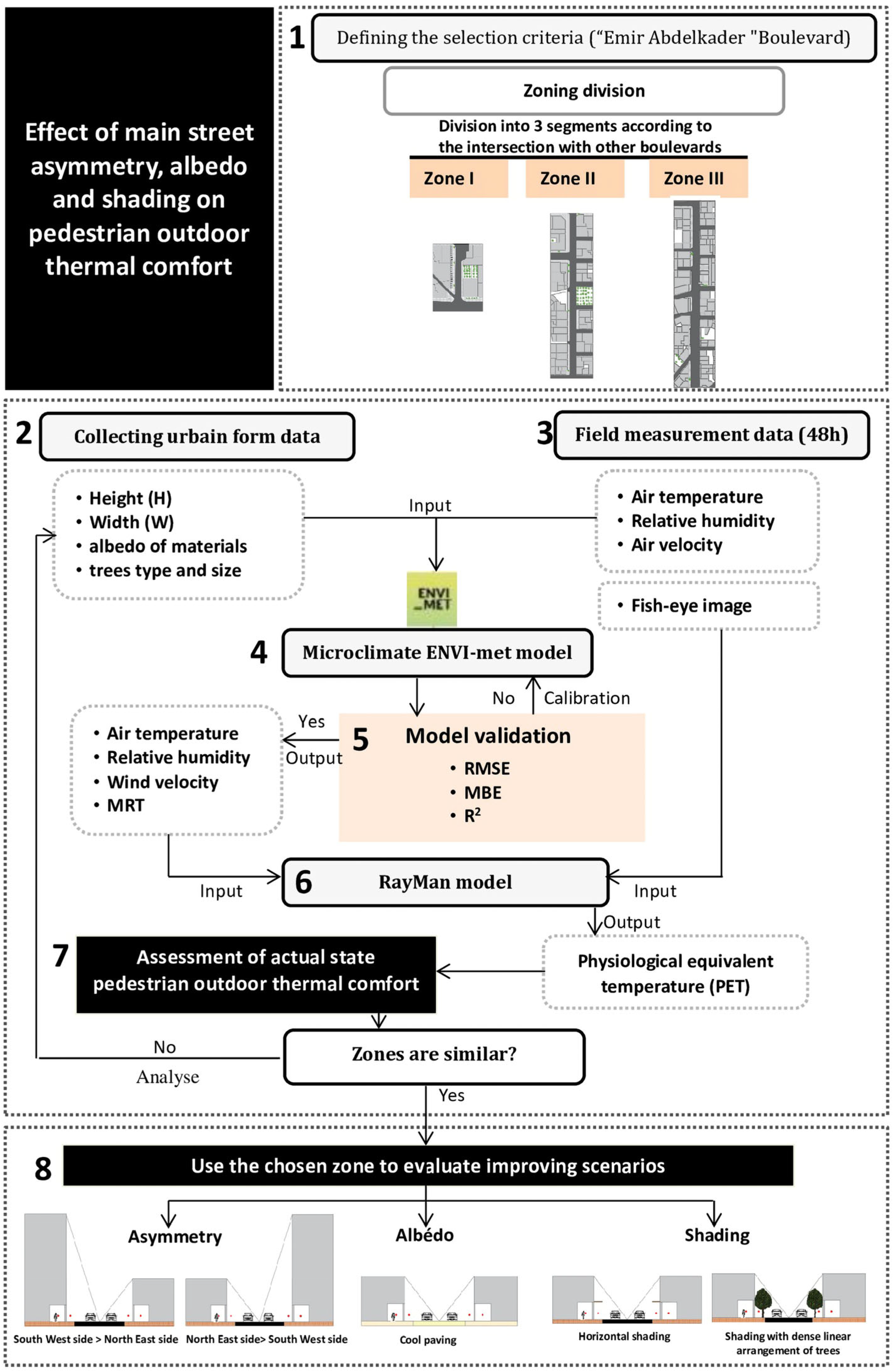

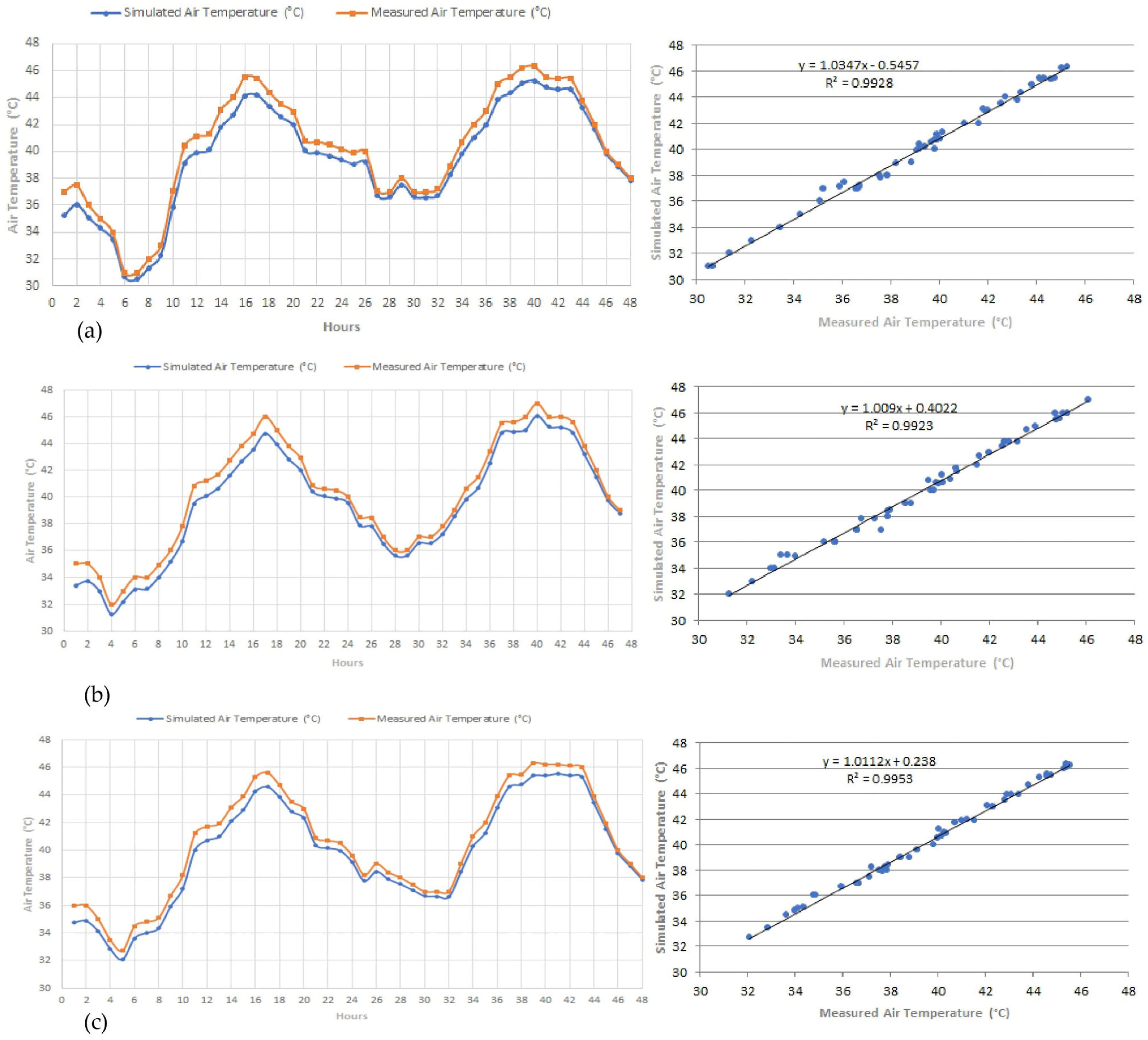
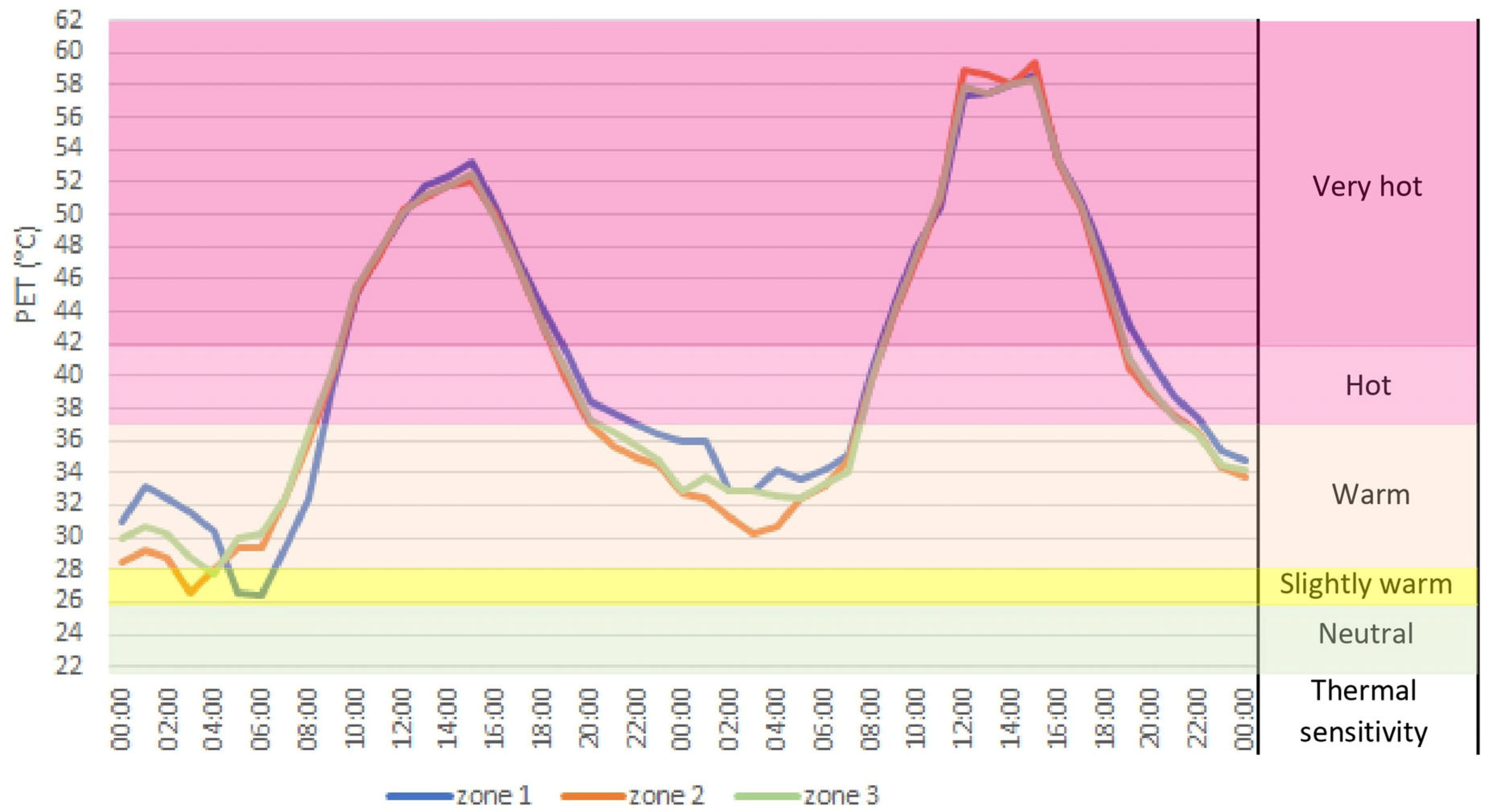



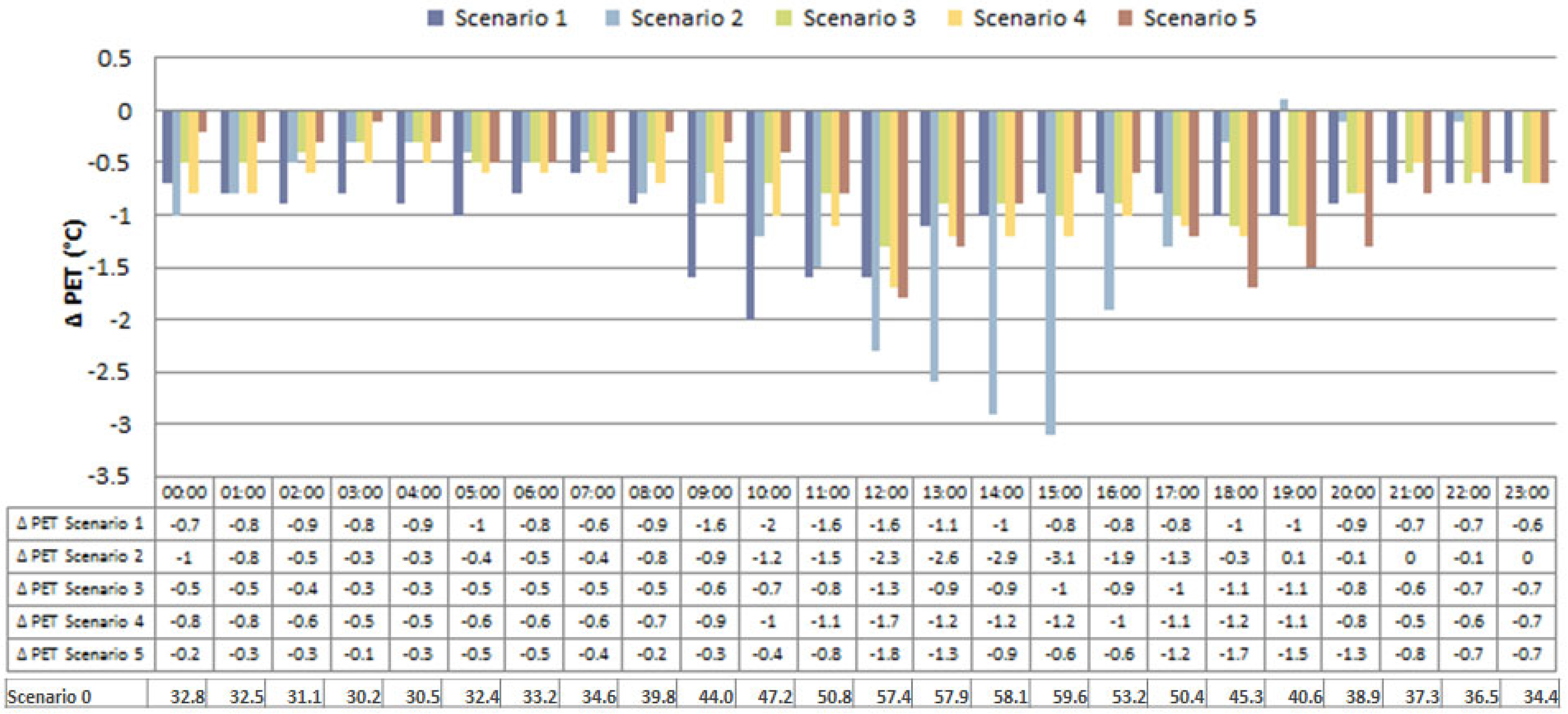
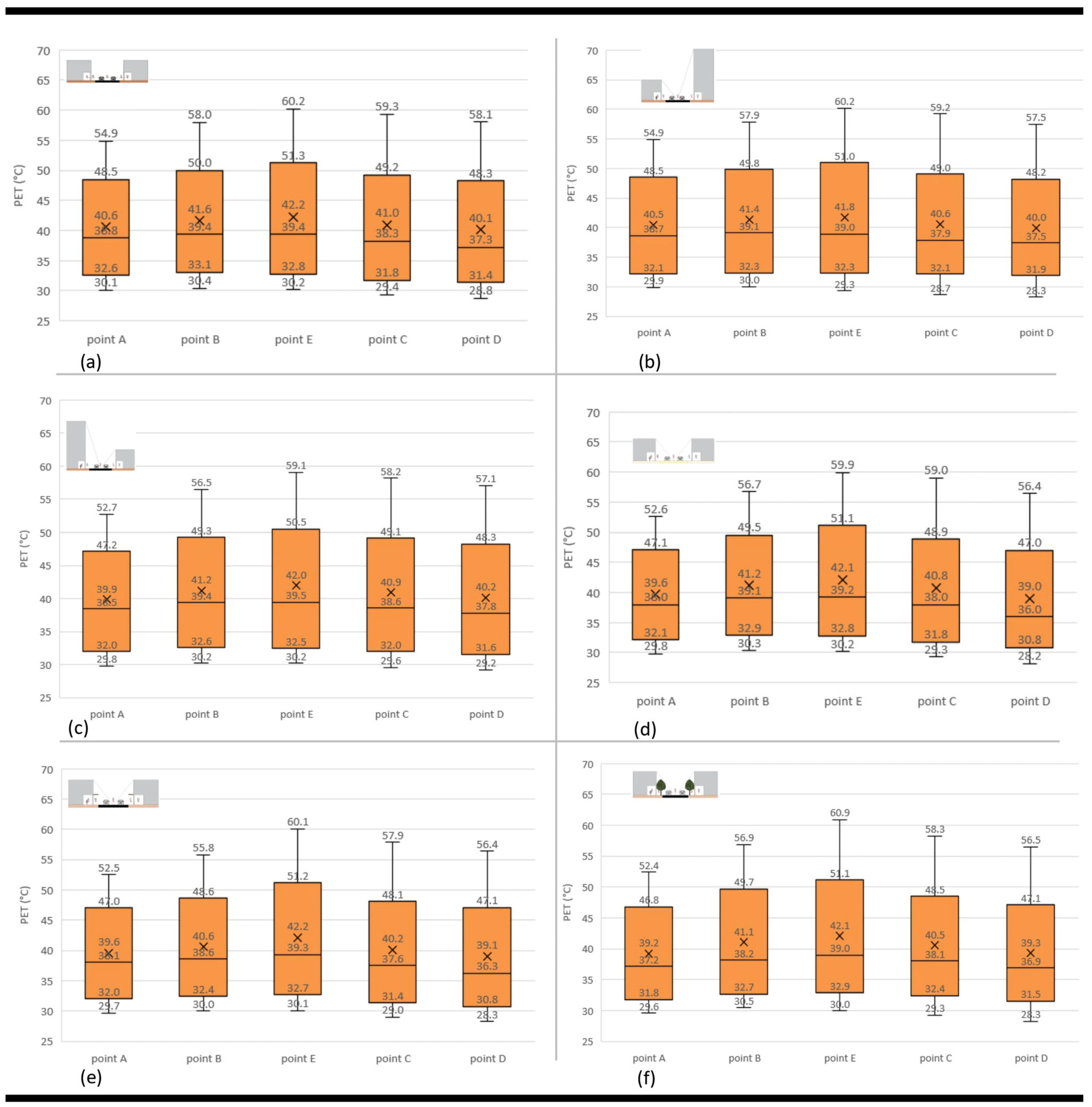
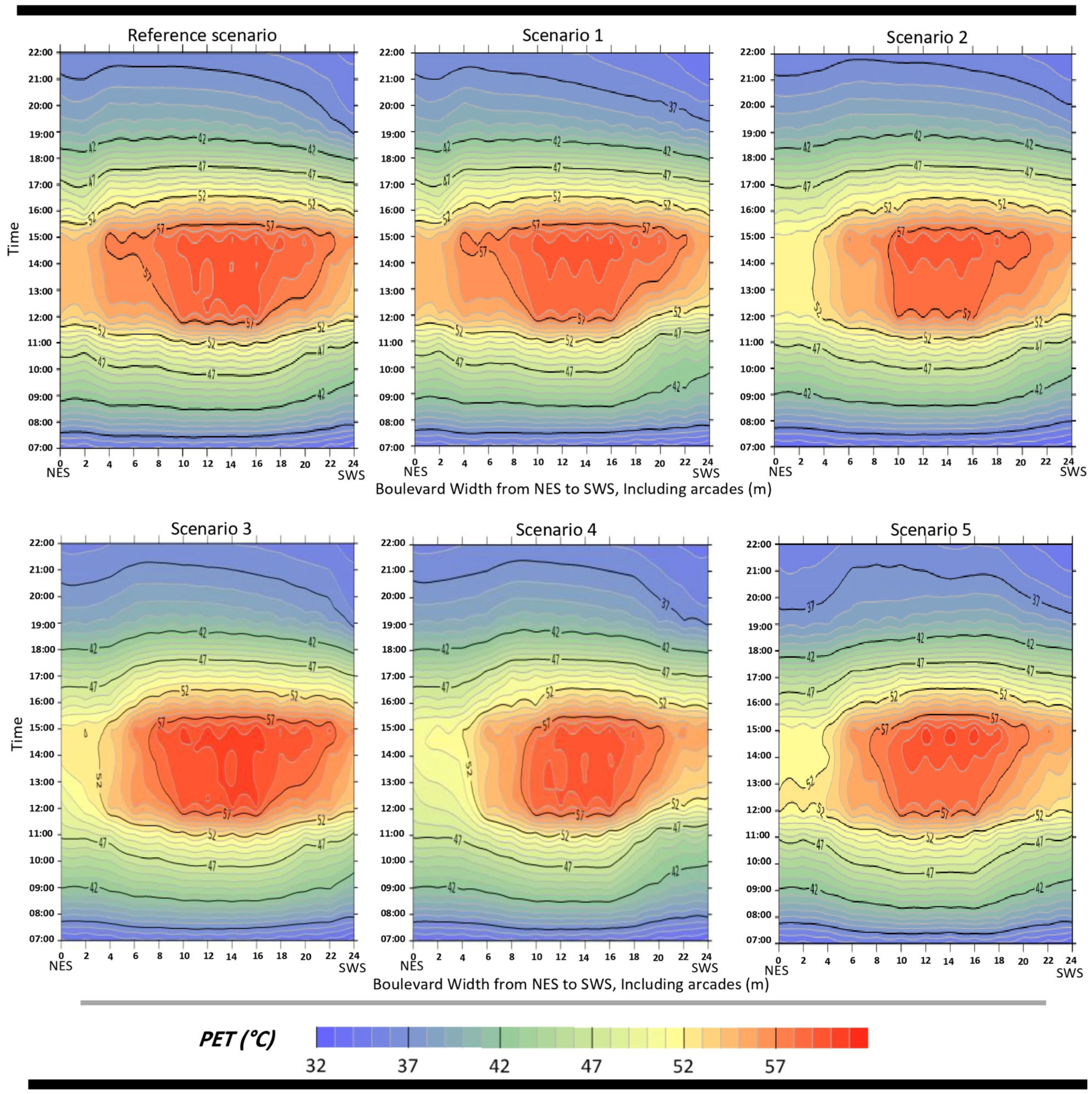
| Zone 1 | Zone 2 | Zone 3 | Scenarios | ||||||
|---|---|---|---|---|---|---|---|---|---|
| SC0 | SC1 | SC2 | SC3 | SC4 | SC5 | ||||
| Model location | Biskra (34°48′ N; 5°44′ E) | ||||||||
| Domain size (m): | |||||||||
| X Direction | 100 | 100 | 100 | 100 | 100 | 100 | 100 | 100 | 100 |
| y Direction | 116 | 304 | 360 | 304 | 304 | 304 | 304 | 304 | 304 |
| Z Direction | 30 | 40 | 50 | 30 | 50 | 50 | 30 | 30 | 30 |
| Spatial resolution (X, Y, Z) | 2 m × 2 m × 2 m (in Z direction, lowest grid box is split into 5 sub-cells) | ||||||||
| Model rotation | 315° | ||||||||
| Total simulation time | 48 h | ||||||||
| Date of simulation | 7 and 8 August 2021 | ||||||||
| Meteorological inputs | Full forcing (CSV file) | ||||||||
| Building material | Wall: hollow block concrete; Roof: cast dense concrete | ||||||||
| Road soil | Asphalt. | Asphalt. | Asphalt. | Asphalt. | Asphalt. | Asphalt. | Stamped light concrete | Asphalt. | Asphalt. |
| Sidewalk’s soil | Brick yellow stone | Brick yellow stone | Brick yellow stone | Brick yellow stone | Brick yellow stone | Brick yellow stone | Concrete pavement light | Brick yellow stone | Brick yellow stone |
| Alignment trees | New deciduous Trees: Spherical (15 m); Palm Trees: medium (15 m); Ficus Retusa Trees: medium (15 m) | / | / | / | / | / | Ficus Retusa Trees: medium (15 m) | ||
| Emir Abdelkader Boulevard | ||||||
|---|---|---|---|---|---|---|
| Indices | Zone 1 | Zone 2 | Zone 3 | |||
| RMSE | 0.91 | 2.26% | 0.84 | 2.10% | 0.74 | 1.38% |
| MBE | −0.83 | −2.07% | −0.78 | −1.95% | −0.69 | −1.71% |
| R² | 0.9928 | 0.9923 | 0.9953 | |||
| PET (°C) | Thermal Sensitivity | Grade of Thermal Stress |
|---|---|---|
| >42.0 | Very hot | Extreme heat stress |
| 37.1–42.0 | Hot | Strong heat stress |
| 28.1–37.0 | Warm | Moderate heat stress |
| 26.1–28.0 | Slightly warm | Slight heat stress |
| 17.1–26.0 | Neutral | No thermal stress |
| 13.1–17.0 | Slightly cool | Slight cold stress |
| 8.1–13.0 | Cool | Moderate cold stress |
| 6.1–8 | Cold | Strong cold stress |
| <6.0 | Very cold | Extreme cold stress |
| Plan View of the Reference Scenario (SC0) | Proposed Scenarios | ||
|---|---|---|---|
| 3D View | Section | ||
 | Scenario 1 | 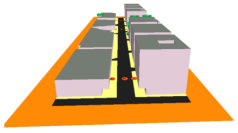 | 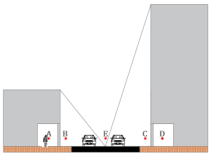 |
| Scenario 2 |  | 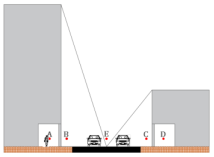 | |
| Scenario 3 | 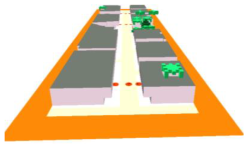 |  | |
| Scenario 4 |  |  | |
| Scenario 5 | 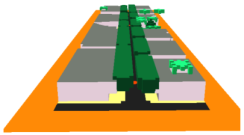 |  | |
| •→Receptors | |||
| Strategy | Arcades | Asymmetric Profile | High Albedo | Horizontal Shading | Shading by Trees | |||||
|---|---|---|---|---|---|---|---|---|---|---|
| Position | SWS | NES | SWS > NES | NES > SWS | sidewalk | road | SWS | NES | SWS | NES |
| Preference choice | ✓ | ✓ | ✓ | ✕ | ✓ | ✕ | ✕ | ✓ | ✓ | ✕ |
Disclaimer/Publisher’s Note: The statements, opinions and data contained in all publications are solely those of the individual author(s) and contributor(s) and not of MDPI and/or the editor(s). MDPI and/or the editor(s) disclaim responsibility for any injury to people or property resulting from any ideas, methods, instructions or products referred to in the content. |
© 2024 by the authors. Licensee MDPI, Basel, Switzerland. This article is an open access article distributed under the terms and conditions of the Creative Commons Attribution (CC BY) license (https://creativecommons.org/licenses/by/4.0/).
Share and Cite
Necira, H.; Matallah, M.E.; Bouzaher, S.; Mahar, W.A.; Ahriz, A. Effect of Street Asymmetry, Albedo, and Shading on Pedestrian Outdoor Thermal Comfort in Hot Desert Climates. Sustainability 2024, 16, 1291. https://doi.org/10.3390/su16031291
Necira H, Matallah ME, Bouzaher S, Mahar WA, Ahriz A. Effect of Street Asymmetry, Albedo, and Shading on Pedestrian Outdoor Thermal Comfort in Hot Desert Climates. Sustainability. 2024; 16(3):1291. https://doi.org/10.3390/su16031291
Chicago/Turabian StyleNecira, Hakima, Mohamed Elhadi Matallah, Soumia Bouzaher, Waqas Ahmed Mahar, and Atef Ahriz. 2024. "Effect of Street Asymmetry, Albedo, and Shading on Pedestrian Outdoor Thermal Comfort in Hot Desert Climates" Sustainability 16, no. 3: 1291. https://doi.org/10.3390/su16031291
APA StyleNecira, H., Matallah, M. E., Bouzaher, S., Mahar, W. A., & Ahriz, A. (2024). Effect of Street Asymmetry, Albedo, and Shading on Pedestrian Outdoor Thermal Comfort in Hot Desert Climates. Sustainability, 16(3), 1291. https://doi.org/10.3390/su16031291








